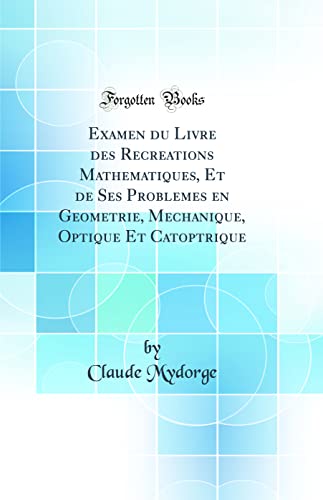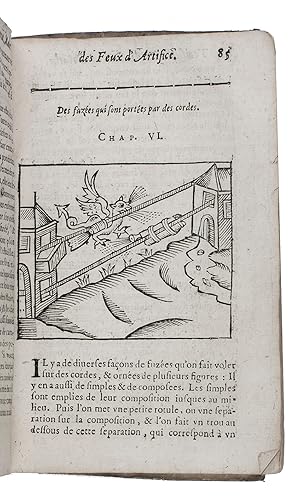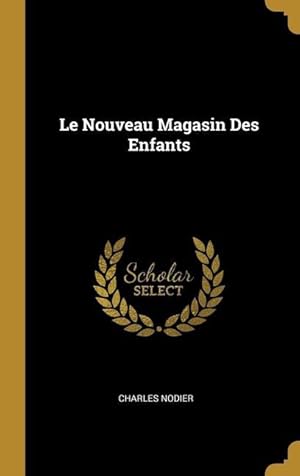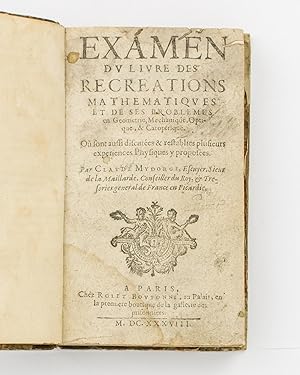mydorge claude (5 Ergebnisse)
Produktart
- Alle Produktarten
- Bücher (5)
- Magazine & Zeitschriften
- Comics
- Noten
- Kunst, Grafik & Poster
- Fotografien
- Karten
-
Manuskripte &
Papierantiquitäten
Zustand
Einband
- alle Einbände
- Hardcover (3)
- Softcover
Weitere Eigenschaften
- Erstausgabe
- Signiert
- Schutzumschlag
- Angebotsfoto (3)
Gratisversand
Land des Verkäufers
Verkäuferbewertung
-
Examen du Livre des Recreations Mathematiques, Et de Ses Problemes en Geometrie, Mechanique, Optique Et Catoptrique (Classic Reprint)
Verlag: Forgotten Books, 2018
ISBN 10: 036520370XISBN 13: 9780365203704
Anbieter: Buchpark, Trebbin, Deutschland
Buch
Zustand: Sehr gut. Zustand: Sehr gut - Gepflegter, sauberer Zustand. | Seiten: 450 | Sprache: Französisch.
-
Examen du livre des recreations mathematiques.Rouen, Charles Osmont, 1643, 8vo. With numerous woodcut illustrations illustrating the problems. Contemporary limp vellum.
Anbieter: Antiquariaat FORUM BV, Houten, Niederlande
[1], [1 blank], [5], [1 blank], [7], [1 blank], 280, 63, [1 blank], [1], [1 blank], [2], 67-106, [43], [1 blank] pp.Very rare fourth edition of the commentary of Claude Mydorge (1585-1647) on the Récreations mathématiques by "H. van Etten" (Jean Leurechon). Mydorge corrected the numerous mistakes made by Leurechon in these mathematical diversions and "added several physical experiments as well as comments that he claimed were intended only for his friends". Several of examples and comments by Mydorge, also appear in the works of his friend Descartes, making it "reasonable to conclude that many of the other mechanical problems discussed by Mydorge in this work were also known to Descartes and one can easily imagine Descartes as one of the friends participating in the discussions of these problems alluded to in the prefatory remarks" (Hattab).The "diversions" consist of numerous problems for which a mathematical solution is presented, most of them illustrated by a woodcut. For instance, Mydorge (following Leurechon) informs the reader how to make water in a glass boil without fire, "to make a door open from both sides; to build a bridge all round the earth which will not fall when its supports are removed; to keep all the water in the world in the air without a single drop falling to earth". The third chapter, on fireworks, contains even more spectacular problems, such as "if all the gunpowder in the world were put in a globe of glass or paper and set on fire all at once, what would happen? Nothing, since the pressure would be equal in every direction" (Thorndike).Binding soiled and spine with a few holes; lower part loose in binding. First 50 pages creased; several marks and thumbing throughout. A fair, probably well-used copy.l Worldcat (1 copy); for Mydorge: DSB IX, pp. 598-599; Hattab, Descartes on forms and mechanisms, pp. 90-92; Thorndike VII, pp. 593-594.
-
Prodromi Catoptricorum et Dioptricorum: sive conicorum operis ad abdita radii reflexi et refracti mysteria praevii & facem praeserentis. Libri primus et secundus. D.A.L.G.
Verlag: Parisiis: Ex typographia I. Dedin?, 1631
Anbieter: Nigel Phillips ABA ILAB, Chilbolton, Vereinigtes Königreich
Small folio, 6 leaves (including the initial blank), 134 pages, 2 leaves (errata). Woodcut device on title, woodcut head- and tailpieces and initials, diagrams in the text. Comtemporary vellum. This copy has been water-damaged at an early stage; the front endpapers and the initial blank are ragged, and the fore-edge and lower margins of the title-page are partly missing, the vellum is a bit stained and the paper is wrinkled but otherwise in good condition and only very lightly discoloured or stained.Presentation copy, inscribed by the author in the lower margin of the title-page to Christian S. Zeuggman, and signed by Mydorge with his full name rather than usual sign ?D.A.L.G.? FIRST EDITION of Mydorge?s important and original work on conic sections, presented as a geometric basis of reflective and refractive optics. ?In his study of conic sections Mydorge continued the work of Apollonius, whose methods of proof he refined and simplified? Mydorge asserts that if from a given point in the plane of a conic section radii to the points of a curve are drawn and extended in a given relationship, then their extremities will be on a new conic section similar to the first. This statement constitutes the beginning of an extremely fruitful method of deforming figures; it was successfully used by La Hire and Newton, and later by Poncelet and, especially, by Chasles, who named it déformation homographique? Mydorge?s works on conic sections contain hundreds of problems published for the first time, as well as a multitude of ingenious and original methods that later geometers frequently used, usually without citing their source.? Finally it should be noted that the term ?parameter? of a conic section was introduced by Mydroge? (DSB). ?By the time of the Prodromi, Mydorge had intimate knowledge of the optical properties of curves and surfaces and had developed descriptions based not on their figures as produced by sectioning a cone, but rather on their focal properties. He was equally interested in, and inventive of, ways in which to actually produce these curves. Both aspects would define the Prodromi? (DiLaura). This first edition contains the first two Books, and is much rarer than the second edition of 1639 which contained all four Books. As in the Columbia, BNF and Horblit (now at Zürich) copies (and possibly in the only other copy recorded by OCLC, at NYPL), this copy has a manuscript correction relating to page 36 signed ?D.A.L.G.? and a small stamp with the author?s arms in the lower margin of the first page of errata. DiLaura, Bibliotheca Opticoria, 71.
-
Examen Dv Livre Des Recreations Mathematiqves: Et De Ses Problemes En Geometrie, Mechanique, Optique, & Catoptrique. Où Sont Aussi Discutées & Restabl
Verlag: WENTWORTH PR, 2018
ISBN 10: 0270996885ISBN 13: 9780270996883
Anbieter: moluna, Greven, Deutschland
Buch
Gebunden. Zustand: New.
-
Examen du Livre des Recreations Mathematiques, et de ses Problemes en Geometrie, Mecanique, Optique et Catoptrique. Où sont aussi discutées & restablies plusieurs experiences Physiques y proposées
Verlag: Chez Rolet Boutonné, Paris, 1638
Anbieter: Michael Treloar Booksellers ANZAAB/ILAB, Adelaide, SA, Australien
Hardcover. 2nd Edition. Paris, Chez Rolet Boutonné, 1638 [second edition]/ 1630. Octavo (170 × 105 mm), four parts bound as one volume, [xvi], 280; 64 (last blank); [63]-106, [12] (index, last three blank); and 39, [1] (blank) pages with woodcut printer's devices on the four title pages, and 84 illustrations throughout (approximately 80 woodcut illustrations and a few type-set diagrams). There are five leaves missing from the 'Troisième Partie' (F4, F5, G1, G4 and G5: pages 85-90, 95-96, and 101-104). Nineteenth century half calf and marbled boards (now lacking the leather corner-pieces, revealing earlier full vellum boards underneath); covers a little worn; light tidemark to the bottom inner corner of the text block throughout; a little worming to the top (blank) margin of the first 25 leaves; insect damage to the bottom edge (extending at most a few millimetres into the wide blank bottom margins); first title leaf dusty and a little soiled; the five missing leaves notwithstanding, overall a very presentable copy. The second edition of Claude Mydorge's expanded edition and critique of this popular early work of recreational mathematics, first published in 1624 and usually attributed to Jean Leurechon. Each of Leurechon's mathematical problems is reprinted here in roman type, with Mydorge's explanatory notes and criticism following in italic. The third part, albeit relatively insubstantial (only 44 well-illustrated pages), is devoted exclusively to fireworks and their construction, which probably explains the few missing leaves. The subtitle is: 'Composée d'un receuil de plusieurs plaisantes & recreatives inventions de feux d'artifice, plus la maniere de faire toutes sortes de fuzées, tant simples que doubles, avec leur composition, le tout representé par figures [sic]' [Comprising a collection of several pleasant and recreative inventions of fireworks, plus the manner of making all sorts of rockets, both single and double, with their composition, all represented in figures]. This third part, together with the second, made its first appearance in a 1628 edition of 'Récréations Mathématiques' published by Charles Osmont at Rouen. Their authorship has not been established (HEEFER, Albrecht: 'Récréations Mathématiques (1624), A Study on its Authorship, Sources and Influence', revised 7 October 2004). The fourth part, 'Nottes [sic] sur les Recreations .' is by D.H.P.E.M. [Denis Henrion, Professeur ès Mathématiques]. Claude Mydorge (1585-1647), French mathematician, was a friend of René Descartes, with whom he shared a strong interest in optics and the nature of vision. 'Mydorge's first major work was the "Examen du livre des Récréations mathématiques", published in 1630. As the title suggests, it was a work on recreational mathematics and was effectively a critique of Laurechon's [sic] book on the theme ['Récréations mathématiques' by the French Jesuit, Jean Leurechon, writing under the pen name of van Etten, first appeared in 1624]. However, it was through his work on conic sections that Mydorge made the greatest scientific impact' (The Cambridge Descartes Lexicon, online). Provenance: a 1713 signature on the first page; an early ownership inscription ('Micha[el] Hutchins His Book') on a preliminary page; 'G.S. Kingston Sept 1834' on the front pastedown: Sir George Strickland Kingston (1807-1880), the South Australian pioneer, engineer and politician (deputy-surveyor-general under Colonel William Light, co-discoverer of the River Torrens, first Speaker in the House of Assembly.






